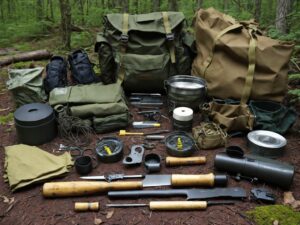Introduction
I bet you’re here because, like me, you’ve felt that tingling sensation of uncertainty, that urge to be ready for whatever Mother Nature throws at us. We’re not just about giving you a gear list to check off; we’re all about the experience, the stories, the lessons learned, and the assurance that when the unexpected comes knocking, you’ve got your bases covered.Dive into Survival Preparedness
Alright, let’s break it down. Survival preparedness isn’t just about stashing canned beans or owning the shiniest multitool. Think of it as life insurance. It’s about anticipating what could go wrong – be it a natural disaster, power failure, or, heavens forbid, a zombie apocalypse (kidding… or am I?) – and setting yourself up to handle it. It’s a lifestyle choice, blending physical preparation with knowledge, mental resilience, and community collaboration. So, whether you’re prepping for an extended power outage or a surprise snowstorm, a solid shtf plan can be your best buddy.Why We Need to Talk About SHTF (Shit Hits The Fan) Scenarios
Picture this: one moment you’re sipping your morning coffee, and the next, you’re in the middle of a blackout with news of a city-wide evacuation. Sounds dramatic, right? But it’s these sudden, jarring SHTF scenarios that we need to be wary of. From financial meltdowns to catastrophic natural disasters, these are the times when our regular safety nets might crumble. The local grocery store? Empty. The cell network? Jammed. In these critical moments, your shtf survival gear and your wit are what will see you through.Key Takeaways
- Survival isn’t about paranoia; it’s about proactive preparation.
- The real essence of SHTF scenarios? Expect the unexpected.
- A blend of the right gear, knowledge, and a sprinkle of audacity makes for the best survival cocktail.
Essential Survival SHFT Bushcraft Gear for SH*T Hit The Fan Situations
The Heart of Shelter and Bedding
Imagine being caught in a storm, with rain pounding above and mud squelching below. Your first thought? Find shelter. In the unpredictable environment of an SHTF scenario, your choice of shelter isn’t just about comfort; it’s about survival. From keeping you dry in a downpour (thank heavens for rain gear) to shielding you from scorching sun or biting cold, your shelter is your castle.Shelter Choices: Tent, Tarp, or Nature’s Own?
The modern adventurer is spoilt for choice. Tents, with their structural integrity, offer a home away from home and are a staple in most camping gear collections. Tarps? They’re the unsung heroes, lightweight and versatile, perfect for those who love tweaking their setups. And sometimes, Mother Nature herself offers a haven. Caves, large fallen trees, or even dense thickets can provide makeshift shelter. But remember, always scout for critters or potential hazards!
Sleeping Gear: More than Just a Good Night’s Sleep
Sleep rejuvenates, and in survival situations, it’s your recharge button. Survival sleeping gear is your cocoon. Depending on the climate, choose a sleeping bag that’s just right. Those rated for colder temperatures are lifesavers in icy conditions. Sleeping pads? They’re your mattress in the wild, insulating against cold and offering that layer of comfort. And let’s not forget the trusty blanket, especially if it’s wool. It’s like a warm hug on those chilly nights.Insulation and Moisture Protection: The Unsung Heroes
Ever tried sleeping in wet clothes? It’s miserable. Staying warm and dry isn’t a luxury; it’s your ticket to staying healthy and functional. Good insulation is like a barrier, keeping the cold out and trapping the warmth. And moisture protection? It’s your shield against rain, dew, or ground dampness. Always look for waterproof or water-resistant gear. Your future self, snug and dry, will thank you!Firestarting Tools
Ah, fire! It’s been humanity’s ally since the caveman days. Whether it’s the mesmerizing dance of the flames or the warmth it radiates, there’s comfort in fire. But beyond the aesthetics, fire is your Swiss Army knife in survival situations. Warmth, purified water, cooked food, or even a beacon for help – fire’s got you covered.Ways to Ignite the Spark: Ferro Rod, Waterproof Matches, Lighter
The beauty of fire is in its simplicity, but starting one requires skill. The ferro rod is like the old reliable friend – always there, sparking joy (pun intended) even when damp. Waterproof matches? They’re your quick-fix solution, ready to ignite even after a dip in water. And lighters, they’re the convenient buddies, always ready for action. For a detailed deep dive, our how to start a fire without matches guide is a must-read.
Fire’s Multifaceted Role
The warmth of a fire is a shield against the cold, warding off hypothermia. Hungry? Fire lets you cook, ensuring you’re not munching on questionable raw foods. Need clean water? Boiling’s the way to go. Lost and need to signal for help? A fire can be your beacon. Plus, on those lonely nights, the flickering flames, the crackling wood, they’re like companions, lifting your spirits.Choosing Your Firestarter: Portability and Reliability
If you’re a newbie, start with a user-friendly firestarter – perhaps a compact windproof lighter or a basic fire starter kit. If you’re a seasoned pro, a ferro rod might be more your style, given its durability and longevity. Pro tip? Always have backups and store them in waterproof containers.Cutting and Tools
Ever tried opening a can without a can opener? Or cutting rope without a knife? In the wild, the right tool can be a lifesaver. Whether it’s for constructing, repairing, or even self-defense, a reliable set of tools is golden.The Essentials: Knives, Multi-tools, Axes
The bushcraft knife is the Swiss Army knife of the wilderness – versatile and always ready for action. For those “I wish I had a…” moments, multi-tools are the answer, combining various functionalities in one compact package. And for those heavy-duty tasks – chopping wood or building a robust shelter, nothing beats a good axe.What to Look for in Tools?
When choosing tools, think of the three Vs: Versatility (can it multitask?), Durability (will it last?), and Viability (is it easy to use?). A tool that ticks these boxes will not only save you time and effort but also be a reliable companion in challenging situations.Maintenance in the Wilderness
A well-loved tool is a well-maintained one. Clean it regularly to ward off rust, and keep those blades sharp. A honing stone is great, but in a pinch, even the rough edge of a rock can serve as a makeshift sharpener.Water Filtration and Purification
Imagine being parched, your throat dry, lips cracked, and the only water source in sight is a murky puddle or a questionable stream. This is where water filtration and purification come into play, turning that dubious source into life-saving hydration.The Lifeblood of Survival: Clean Water
Water is paramount. Our bodies can cruise without food for a while, but without water, we’re running on borrowed time. In survival situations, you’ll often find water, but it won’t always be pristine. Drinking unfiltered water is like playing Russian roulette with pathogens and bacteria – a risk you don’t want to take.Filtering vs. Purifying: Know the Difference
Water filters, like the popular survival straw, sieve out contaminants. They trap sediments and many microorganisms, making water safer to drink. But to ensure that every tiny potential threat, like viruses, is neutralized, you need purification. Boiling is a tried-and-true method. For those on the move, water purification tablets or UV purifiers offer a lightweight solution. For an in-depth guide on water solutions, don’t miss our ultimate guide to SHTF survival gear essentials.
Recommendations: Stay Light, Stay Safe
For backpackers or those on the move, a survival straw or collapsible bottle with a built-in filter is invaluable. They’re lightweight and compact. If you have a bit more space, a hand pump filter can process larger quantities of water, perfect for groups. Always complement filtration with purification, especially if you’re unsure of the water source’s quality.Navigation and Communication
Imagine being lost, the surroundings unfamiliar, with no cell service. Sounds like a nightmare, right? In an SHTF scenario, when traditional communication lines might be down, and familiar landmarks destroyed, navigation and communication tools are not just for convenience; they’re essential for survival.Finding Your Way: Compasses and Maps
The good old compass, when paired with a map, is a powerhouse. Even without batteries or satellite signals, this duo can help you find your way. Learning basic navigation skills, understanding topographical maps, and being able to determine direction using natural cues can be game-changers.Staying Connected: Radios and Signaling Devices
Two-way radios can be lifesavers, especially if you’re in a group or waiting for updates from emergency services. They don’t rely on cell towers and can work over considerable distances. Signaling devices, whether it’s a whistle, flare, or signal mirror, can help alert rescuers or communicate with others without vocalizing.Skills and Responsibility
While tools are fantastic, knowledge is the real power. Learn how to use them efficiently. And always remember, especially with tools like flares or radios, to use them responsibly. False alarms can divert vital resources in emergency scenarios.What Essential Items Should I Include in My Survival Kit?
When assembling your shtf kit essentials for survival situations, consider including items such as a first aid kit, water purification tablets, a multi-tool, a flashlight with extra batteries, a compass, and non-perishable food. These essential items will help you navigate through emergencies and ensure your basic needs are met when disaster strikes. Stay prepared, stay safe.
What survival gear do I need?
| Type of Gears | Examples |
|---|---|
| Shelter | Tent, tarp, emergency blanket |
| Firestarting | Lighter, waterproof matches, ferro rod |
| Water | Filtration straw, purification tablets |
| Food Procurement | Compact fishing kit, snares |
| Tools | Bushcraft knife, multi-tool, axe |
| Navigation | Compass, topographical map |
| Communication | Whistle, two-way radio |
| First Aid | Bandages, antiseptics, tourniquet |
| Clothing | Rain gear, thermal wear, hiking boots |
| Lighting | Hand-crank flashlight, glow sticks |

What are the essential items you need for SHTF situations?
- Clean Water Source: Always ensure you have a way to access or purify water. Consider carrying bottled water and a purification method like tablets or a filtration straw.
- Reliable Shelter: This could be a lightweight tent, a tarp, or even an emergency thermal blanket.
- Fire Source: Waterproof matches, lighters, or a ferro rod can be indispensable when you need warmth or a way to cook food.
- Nutrition: Non-perishable food items like energy bars, canned goods, or even MREs (Meals Ready to Eat). Also, tools or kits for hunting and fishing can come in handy.
- First Aid Supplies: A good first aid kit with bandages, antiseptic wipes, a tourniquet, and basic medication.
- Navigation Tools: Don’t underestimate the value of a good old-fashioned compass and map. GPS devices are great, but they rely on battery power.
- Multi-purpose Tools: A bushcraft knife or multi-tool can serve various purposes, from building shelter to preparing food.
- Communication Devices: In the absence of cell service, a whistle or two-way radio can be vital for signaling or communication.
- Clothing: Depending on the environment, ensure you have protective clothing. This includes items like rain gear, thermal wear, hats, and sturdy footwear.
- Illumination: A reliable light source, be it a hand-crank flashlight, traditional torch, or even glow sticks, is crucial, especially during the night or in low-light conditions.
Food Procurement and Storage
Hunger is a gnawing, persistent feeling, and in survival situations, it’s more than just discomfort. It’s a drain on your energy and morale. But fear not, with the right know-how and tools, you can turn the wilderness into a pantry.From Nature’s Bounty: Foraging, Fishing, and Hunting
Food Preservation: The Art and Science
Once you’ve got food, preserving it becomes crucial, especially if you’re planning to stay put for an extended period. Drying, smoking, or even burying it in cool ground can help prolong its shelf life. Knowing these techniques ensures you have a food supply even during lean times.Recommended Gear: Portable and Efficient
A compact fishing kit, snares, or even a lightweight bushcraft trap can be part of your shtf kit. For those not trained in hunting, focusing on fishing and foraging might be more feasible. And don’t forget, a good guidebook on local flora can be invaluable.Conclusion
Survival isn’t about the fittest; it’s about the most prepared. With the right bushcraft gear, a sprinkle of knowledge, and a dash of determination, even the harshest SHTF scenario becomes manageable.Reflect and Prepare
Look back at our journey. From understanding the importance of preparedness to diving deep into essential gear and skills, it’s been quite the adventure. But remember, reading is just the first step. Evaluate your current preparedness level, identify gaps, and start filling them.Stay Curious, Stay Prepared!
Your survival journey doesn’t end here. There’s always more to learn, more skills to hone, and more adventures to embark upon. Dive deeper into our blog, explore, ask questions, and most importantly, stay prepared. Because when the unexpected comes knocking, you’ll be ready to greet it with confidence.What Essential Items Should Be Included in the Ultimate Bug Out Bag for Survival?
When it comes to preparing for emergencies, having an ultimate bug out bag for survival is crucial. This comprehensive kit should include essential items like a multi-tool, first aid supplies, water purification tablets, non-perishable food, a durable water bottle, extra clothing, and a reliable flashlight. It’s important to customize your bag based on your specific needs and geographical location.
FAQs
What are the essential items you need for SHTF situations? Here’s a handy bullet list to get you started:- Clean water or purification tools
- Shelter (tent, tarp, or emergency blanket)
- Firestarting tools (lighter, matches, ferro rod)
- Food (non-perishable items or tools for hunting/fishing)
- First aid kit
- Navigation tools (compass, map)
- Communication tools (whistle, two-way radio)
- Multipurpose tools (knife, multi-tool)
- A clear mind: Panic is your enemy.
- Knowledge: Know basic survival skills.
- Community: Team up, collaborate, and pool resources.
- Preparedness: Always have an emergency kit handy.
I’m Alex, the author behind True Survivalist. As a survival enthusiast myself, I’ve created this website to serve as a valuable resource for fellow survivalists and preppers. Whether it’s understanding survival situations, emergency preparedness, or finding the right survival gear, I’ve got you covered. Through a series of informative guides, I aim to provide answers to commonly asked questions, debunk common myths, and help you avoid common mistakes. At True Survivalist, I believe in equipping you with the knowledge and tools you need to be prepared for any survival scenario. Join me on this journey of self-reliance and resilience.
